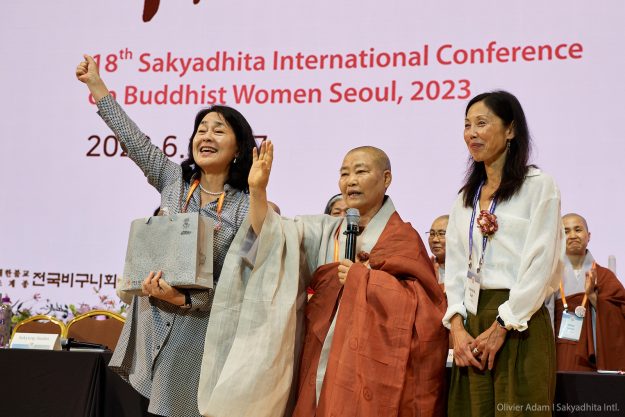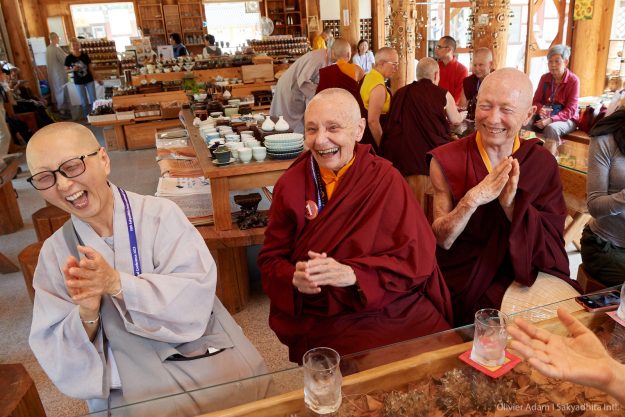Now in its 18th year, the biannual Sakyadhita International Conference took place in Seoul, South Korea this year, from June 23 to 27. Hosted by the Korean Bhiksuni Association and Sakyadhita Korea, three thousand women came together from all over the world to listen to talks, attend diverse workshops, meditate, chant, and think together. As participants and media alike have already expressed, the conference was brilliantly organized, with many moments to savor and enjoy.
It was, however, the size of the gathering that really impressed me. Sakyadhita has never been so big, so vivaciously ambitious. Three thousand women is unprecedented in the conference’s history. When I first walked into the venue, I felt like I was in a stadium (not the feeling Sakyadhita normally generates). The opening ceremony included strobe lights no less!




But once settled in, I realized I was wholly engulfed in a sea of boisterous, joyful Buddhist women, and what was strange quickly felt familiar. Perhaps even ancestral. I felt as though I had become part of the kind of gathering that has been happening since the beginning of time.
It was not just the size of this event that mesmerized me, but how it was organized and cared for. The Korean contingent prepared meals for the entire assembly three times a day. For three thousand of us. While a huge community of women talked, learned, and studied together, others were brewing giant pots of beautiful vegetarian food—noodles and rice, kimchi (so much delicious kimchi!), salads and soups, and so much more. Women chopped, sliced, spiced, and stirred, working with busy hands in the heavy summer heat so that other women could sit together and explore.


We lined up in organized rows when a meal was ready. Volunteers greeted us and handed us plates, chopsticks, and smiles. Others heaped piles of food onto our empty plates. “I have enough!” I would try to say, but I would be met with maternal nudging—“Take some more,” “Try some of this,” “Make sure to have dessert.” Three times a day, for three thousand of us, they made sure we ate well.
So much happened at this meeting, so many memories are competing in my mind, but I cannot help but return to the food that we (the great womanly masses that we were) feasted on. And to the women who coordinated almost seamlessly (or so it seemed to me) to ensure everyone was adequately cared for and fed. Food was sometimes put directly into my mouth, so unstoppable was the enthusiasm. There is nothing like food to bring people together. There is something ancestral about that, too.
I have attended many Sakyadhita meetings over the years, and it is always a special gift. The magnitude of this one, though, the sheer size of it, made this meeting feel like a tidal wave. No longer a few hundred hopefuls under a tent, Sakyadhita had become a force. The glass ceiling has no chance of remaining intact when so many women are pushing up against it.


One afternoon, I was having lunch with the abbess of a nunnery from Northern India. It was her first Sakyadhita experience, and she was utterly overwhelmed by all that she saw. I asked her what she hoped to bring back to her nunnery.
“I won’t bring anything back,” she replied.
I lay down my chopsticks. “What do you mean?”
She looked at me carefully for a moment. Then she looked around at the many monastic women from around the world, sitting together at folding tables, eating as a community.
“I can never explain what I have seen here,” she said. “My nuns won’t understand. So I will make sure they come next time, so they can see this for themselves.”




Thank you for subscribing to Tricycle! As a nonprofit, we depend on readers like you to keep Buddhist teachings and practices widely available.
